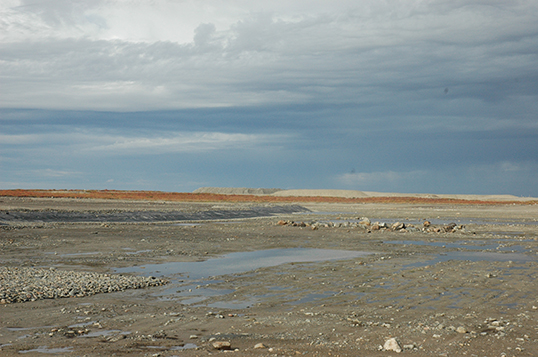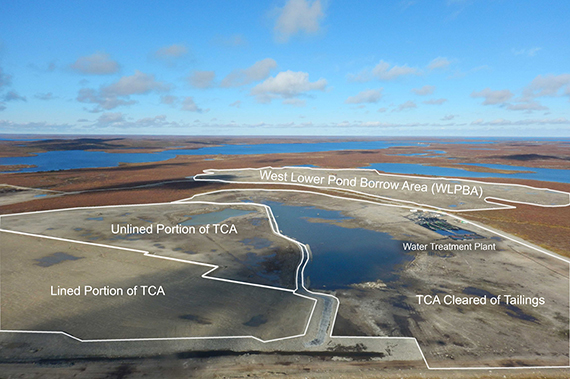Tundra Mine Remediation
Overview
Tundra Mine is a former gold mine located 240 km northeast of Yellowknife in the Northwest Territories. Mine operations began in 1964 and ceased in the mid-1980s. Tundra is one of three mines that reverted to the Government of Canada in 1999 when the owner, Royal Oak Mines Inc., went into receivership. This occurred before Canada implemented the Mine Site Reclamation Policy for the Northwest Territories. Implemented in 2002, this policy states that adequate security be provided by the operator of the mine to ensure the cost of reclamation in case of abandonment. The Government of Canada has therefore funded remediation of this site, as well as care and maintenance, from 1999 to present day.

Caption: This area has been cleared of ore residue called tailings. The tailings have been consolidated into an area that will be covered by a geomembrane liner and gravel. This engineered cap prevents contact with the tailings: fresh rain water flows over the gravel, separated from contaminates by the geomembrane liner.
Engagement approach
The Tundra Mine Remediation Project actively engages Indigenous communities. This is done by providing project updates, and bringing Elders and community representatives from the Yellowknives Dene First Nation and the North Slave Metis Alliance to the site to see the remediation activities in person. The insight they continue to provide is invaluable to Canada when making decisions about how to clean up the mine site area for the safety of Northerners and the environment.
What work has been done?
- 1999
- Care and maintenance of the site included dam repairs, landfill repairs, geotechnical inspections of dams, water management and water quality monitoring.
- 2007
- Initial remediation was completed, including removal of buildings and hazardous waste, construction of a non-hazardous landfill, and capping of mine openings.
- 2009
- Water treatment was carried out on-site to treat the water in the Tailings Containment Area (TCA).
- 2010
- The contract for further remediation was awarded and water treatment of the TCA continued.
- 2011
- Full remediation of the site began in June 2011. This work included water treatment, excavation of hydrocarbon-contaminated soil and the consolidation of tailings solids and buried debris.
- 2012-2014
- Further remediation work occurred, including additional water treatment in the TCA, treating hydrocarbon-contaminated soil, covering tailings and waste rock, and decommissioning dams.
- 2014-2015
- In August 2014, the contractor informed the Government of Canada that it would be unable to complete the remediation contract. The Contract was terminated by mutual consent in April 2015. The site began to be managed through a care and maintenance contract in April 2015.
- 2016
- Care and maintenance activities at the site were completed and a Phase IIB remediation contract was tendered. Canada expects to award the remediation contract in the fall of 2016.
- 2017-2018
- Remediation work resumed in Spring 2017 as per the Remediation Plan submitted to the Mackenzie Valley Land and Water Board. This included:
- treating tailings-impacted water
- consolidating and installing a liner over the tailings containment area (engineered cap construction)
- excavating and treating hydrocarbon-impacted soils
- re-grading the West Lower Pond Borrow Area

Caption: This diagram outlines the remediation activities at the Tundra Mine Remediation Site. To put the image in context, the Water Treatment Plant is roughly the size of 1.5 soccer fields.
What's next?
For the next five years, CIRNAC will actively monitor the site through an adaptive management phase. This includes remote monitoring assisted by cameras and sensors, as well as visits to site to take samples and measurements. The project will then move into the monitoring phase. CIRNAC is committed to ensuring that all clean-up activities work as planned to protect the health of Northerners and the environment.